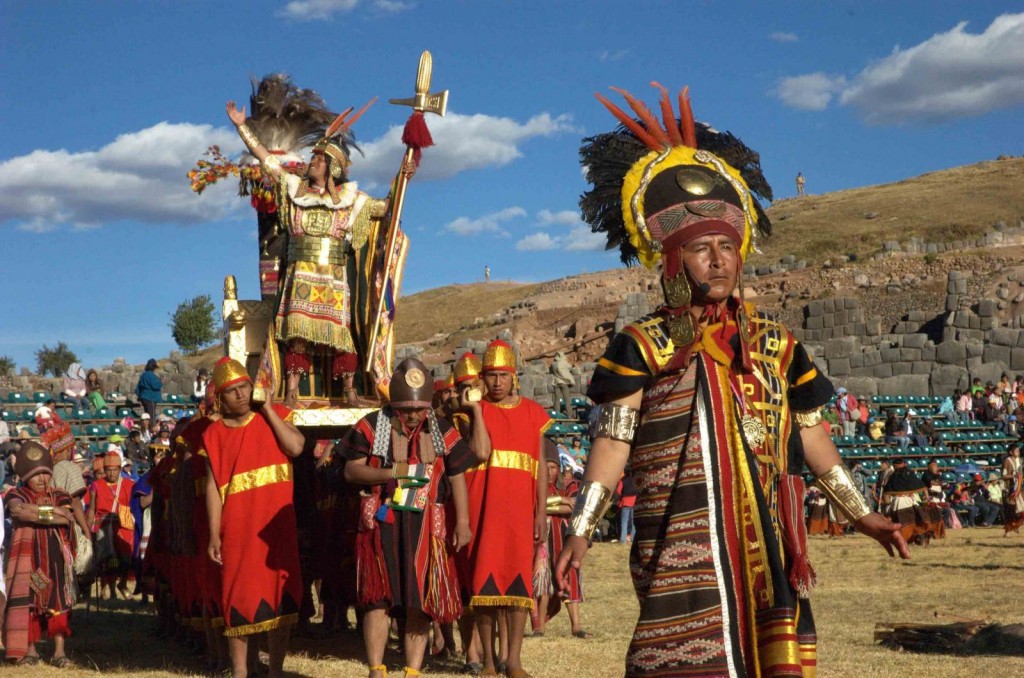Peru’s Festival of the Sun is an all-day celebrations on June 24, the day of Inti Raymi. On this day, the ceremonial events begin with an invocation by the Sapa Inca in the Qorikancha, also spelled Koricancha square in front of the Santo Domingo church, built over the ancient Temple of the Sun. Here, the Sapa Inca calls on the blessings from the sun.
Following the oration, Sapa Inca is carried on a golden throne, a replica of the original which weighed about 60 kilos, in a procession to the ancient fortress of Sacsayhuamán, in the hills above Cuzco. With the Sapa Inca come the high priests, garbed in ceremonial robes, then officials of the court, nobles and others, all elaborately costumed according to their rank, with silver and gold ornaments.
Every day has its events, from daytime expositions, street fairs, and people milling and dancing in the streets. In the evenings, live music from the best of Peruvian musical groups draws the crowds to the Plaza de Armas for free concerts. During the preceding year, in preparation for Inti Raymi, hundreds of actors are chosen to represent historical figures. Being selected to portray the Sapa Inca or his wife, Mama Occla, is a great honor.
Historically, the ceremonies took place at the winter solstice, when the sun is farthest from the earth. Fearing the lack of sun and ensuing famine, the ancient Incas gathered in Cuzco to honor the Sun God and plead for his return. The celebrants fasted for days before the event, refrained from physical pleasures and presented gifts to the Inca, who in return put on a lavish banquet of meat, corn bread, chicha and coca tea as they prepared to sacrifice llamas to ensure good crops and fertile fields.
In 1572, Viceroy Toledo banned Inti Raymi celebrations as pagan and contrary to the Catholic faith. Following the edict, the ceremonies went underground.
It’s currently the second largest festival in South America with hundreds of thousands of people showing up in Cuzco. They walk along flower-bedecked streets, to music and prayers and dancing. Women sweep the streets to clear them of evil spirits. At Sacsayhuamán , where huge crowds await the arrival of the procession, Sapa Inca climbs to the sacred altar where all can see him.
Once all the celebrants are in place in the grand square of the fortress, there are speeches by Sapa Inca, the priests and representatives of the Suyos: the Snake for the world below, the Puma for life on earth, and the Condor for the upper world of the gods.
A white llama is sacrificed (now in a very realistic stage act) and the high priest holds aloft the bloody heart in honor of Pachamama. This is done to ensure the fertility of the earth which in combination with light and warmth from the sun provides a bountiful crop. The priests read the blood stains to see the future for the Inca.
As the sun begins to set, stacks of straw are set on fire and the celebrants dance around them to honor Tawantinsuty or the Empire of the Four Wind Directions. In ancient times, no fire was allowed that day until the evening fires.
The ceremony of Inti Raymi ends with a procession back to Cuzco. Sapa Inca and Mama Occla are carried on their thrones, the high priests and representatives of the Supas pronounce blessings on the people. Once again, a new year has begun.
June 24 is also celebrated throughout Peru as Indians Day or Peasants Day.
Credit: Discovered on About.com and a portion of it was reposted here. Photo credit: SunGodPeru.com.

Renee Blodgett is the founder of We Blog the World. The site combines the magic of an online culture and travel magazine with a global blog network and has contributors from every continent in the world. Having lived in 10 countries and explored nearly 80, she is an avid traveler, and a lover, observer and participant in cultural diversity.
She is also the CEO and founder of Magic Sauce Media, a new media services consultancy focused on viral marketing, social media, branding, events and PR. For over 20 years, she has helped companies from 12 countries get traction in the market. Known for her global and organic approach to product and corporate launches, Renee practices what she pitches and as an active user of social media, she helps clients navigate digital waters from around the world. Renee has been blogging for over 16 years and regularly writes on her personal blog Down the Avenue, Huffington Post, BlogHer, We Blog the World and other sites. She was ranked #12 Social Media Influencer by Forbes Magazine and is listed as a new media influencer and game changer on various sites and books on the new media revolution. In 2013, she was listed as the 6th most influential woman in social media by Forbes Magazine on a Top 20 List.
Her passion for art, storytelling and photography led to the launch of Magic Sauce Photography, which is a visual extension of her writing, the result of which has led to producing six photo books: Galapagos Islands, London, South Africa, Rome, Urbanization and Ecuador.
Renee is also the co-founder of Traveling Geeks, an initiative that brings entrepreneurs, thought leaders, bloggers, creators, curators and influencers to other countries to share and learn from peers, governments, corporations, and the general public in order to educate, share, evaluate, and promote innovative technologies.









